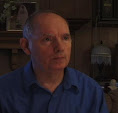The cryptid seen in New Guinea, by Duane Hodgkinson in 1944 and by Brian Hennessy in 1971, I have named "Hodgkinson-Hennessy Ropen." Similarities between the descriptions given to me by these two eyewitnesses struck me as too much for coincidence. In each of our interviews (in different years), they both responded to my visual survey-forms, resulting in composite images of the heads of the creatures observed.
Top: Hennessy's sighting; bottom: Hodgkinson's.
As I mentioned in my scientific paper (in The Creation Research Society Quarterly, Volume 45, Number 3, "Reports of Living Pterosaurs in the Southwest Pacific"), these different lengths of head crest I believe fall within the range of eyewitness error. In other words, the creatures observed by these two men could very well have had the same length of head crest (relative to the size of the head). In addition, I believe that in at least some species of pterosaurs, according to fossil evidence, the head crest grows faster than the rest of the head. Since the crest length is the primary difference between these two sketches, it seems likely that the species is the same for the 1944 and 1971 sightings.
Why would there ever be any question about ropen sightings being of the same species? David Woetzel wrote a scientific paper in The Creation Research Society Quarterly three years before my own paper. (My fellow ropen-seeking cryptozoologist explored Umboi Island, with Garth Guessman and Jacob Kepas, a few weeks after my 2004 expedition) Woetzel concluded that the ropen of Umboi Island is a Rhamphorhynchoid pterosaur similar to the Dimorphodon, even though two eyewitnesses that he and Guessman had interviewed chose a sketch of a Sordes Pilosus (when shown many silhouettes of pterosaurs, bats, and birds). Although I have much doubt about a Dimorphodon-interpretation of the overall reports from Umboi Island, I admit the possibility that two different species of Rhamphorhynchoids may live in Papua New Guinea. But the creatures seen by Hodgkinson and Hennessy seem very likely to have been of the same species, so I have named this cryptid "Hodgkinson-Hennessy Ropen."
Please support this investigation by purchasing a copy of the nonfiction book "Live Pterosaurs in America" (on Amazon.com, from late-2009 through early 2010, the best-selling nonfiction book on sightings of living pterosaurs).
See also: David Woetzel's scientific paper on living pterosaurs and the "fiery flying serpent." (The Creation Research Society Quarterly, Volume 42, Number 4, March, 2006)
See also: Home page of Live Pterosaurs in America. Thank you for supporting the investigations. To contact me, Jonathan Whitcomb, use the Live Pterosaur email form.
Monday, May 3, 2010
Subscribe to:
Post Comments (Atom)


No comments:
Post a Comment